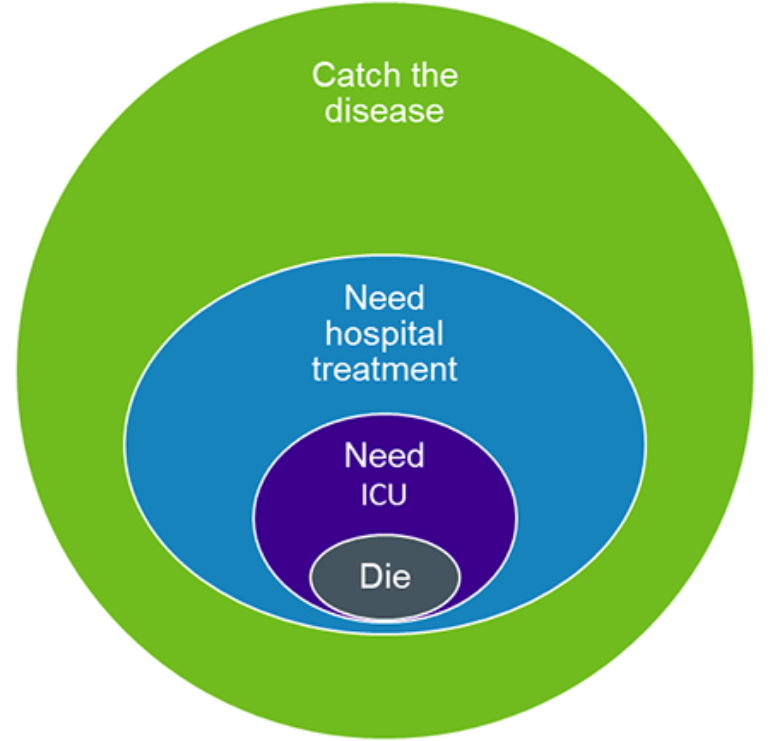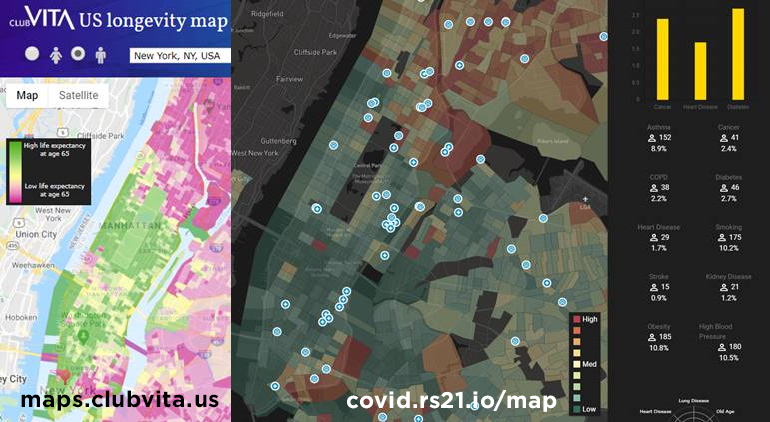The number of Google searches for the word unprecedented has recently spiked to unprecedented levels*.
And for good reason; the COVID-19 pandemic is unlike anything in living memory - and it is not affecting everybody in the same way. Here I set out the reasons why different socioeconomic groups could be affected very differently by the pandemic.
Understanding the consequences and how they differ between socioeconomic groups is going to be a challenge and good data will be key. Of the data readily available to pension plan administrators, where someone lives1 is the most descriptive field for predicting longevity2.
It can be used to capture socioeconomic factors such as population density, urban/rural setting, the likely level of education and lifestyle, the size of the household and the likelihood the home is rented or owned.
We can use postcode (UK) / postal code (Canada) / 9-digit ZIP code (US) to capture a wide spectrum longevity. Sometimes a distance of just one block can make a significant difference to life expectancy and most neighborhoods contain households from right across the socioeconomic spectrum (demonstrated for the US in Club Vita’s US longevity map). So, if less fortunate people are feeling the effects of COVID-19 more severely, they are likely to be your neighbors.
Who will catch the disease?
You have to catch the disease to die from it. Most countries are now looking to deal with the outbreak using suppression tactics, which if successful means that only a subset of the population will catch the disease. There is some early indication that groups with lower socioeconomic status could be more at risk from the spread of the coronavirus, with analysis of New York revealing that poorer neighborhoods have been hardest hit.
The virus spreads through respiratory droplets shed by someone with the virus, meaning it will spread more easily with greater proximity of people, larger contact networks and lower levels of hygiene. Some factors that could increase the risk of catching the disease are:
- Population density. Close contact between people is far greater in urban areas than rural.
- Size of household. One person living alone would need to catch the disease outside of the household. A larger household would have a greater chance of bringing the virus home.
The high proportion of single person households in Sweden has been cited as one reason why stricter social-distancing regulations are not deemed necessary. Conversely, the popularity of multi-generational homes seems to be amplifying the effect of the virus in Italy.

- Level of social distancing. Social distancing is effective at stemming the spread of the virus, but there are a number of reasons different groups may display different levels of social distancing:
- Official advice may not be consistent between areas, guidance in the US for example has even differed between neighboring towns. Access to local guidance may also differ between socioeconomic groups, for example advice only provided online or in certain languages.
- Working from home may reduce social contact, but is only available to some - with a concentration in jobs related to higher socioeconomic status. This (and maybe other factors as well) is resulting in people from higher socioeconomic groups limiting their movement throughout February and March. And clearly, those working in professions such as health care will be more exposed.
- Maintaining stay at home orders will be far more of a challenge for those living in smaller or more crowded accommodation or with no outside space.
- Some groups may be more likely to adhere to social-distancing policies than others. Students at spring break in Florida, beach goers in Bondi, Sydney and pub-goers in the UK were all seen ignoring social-distancing policies in the early stages, whereas the whole nation of Sweden is believed to be responsible enough to follow recommended guidelines.
- Travel. Traveling will increase the number of connections a person makes and increase the likelihood of coming into contact with the virus. Analysis of US cell phone data has shown that different parts of the US are responding to the advice to stop traveling in very different ways. Living in or near a travel hub could also increase the likelihood of exposure.
Who will the disease affect the most severely
Not everyone who catches the disease will react severely to it. Some distinct risk factors that make the effects of COVID-19 more severe are emerging. They are likely to be felt differently by different socioeconomic groups.
- People with pre-existing medical conditions3 of cardiovascular disease, diabetes, chronic respiratory disease, abnormally high blood pressure and cancer are at much greater risk from COVID-19. Cardiovascular disease and diabetes are both more prevalent in groups with lower socioeconomic status.
- The WHO is warning that smokers may be more at risk due to the known effects of smoking on the lungs and smoking is more prevalent in groups with lower socioeconomic status.
- Some commentators have suggested that air pollution may have increased the severity of symptoms in Italy. And whereas travel bans have created some noticeable improvements in air pollution it seems unlikely this would be enough to counter long term effects.
- Different socioeconomic groups will have different levels of access to healthcare. This will be especially prevalent in countries such as the US where there is no universal health care system and where the large number of under or uninsured people are concentrated in certain industries.
- Using data from the CDC and the US census, RS21 have released a map of what they term to be the Urban Health Vulnerability Index, highlighting micro areas housing people with more risk factors for COVID-19.
Comparing their map of Manhattan to Club Vita’s own longevity map (over the page) we see a striking similarity between areas of existing low life expectancy and areas of high vulnerability to the COVID-19.

Who will be left?
If we see an increased number of deaths this year due to COVID-19, who will be left behind?
Certain socioeconomic groups seem more at risk than others. We could therefore realistically expect to see higher numbers of deaths from certain sections of society. This could be very relevant for pension plans using analysis of recent experience of their population to set future mortality assumptions. The future population might look very different to the one at the start of this pandemic.
On the other hand, those groups most at risk seem to be ones that generally already have higher mortality. Any change to demographic make-up of a population hit by COVID-19 will depend on whether increased risks due to COVID-19 are proportionally higher than the increased mortality experienced by those groups in the first place. Monitoring the socioeconomic data will be key.
Will there be a toll of social-isolation policies?
There may even long-lasting effects of the stay-at-home policies currently in place in many areas of the world. For example, loneliness and isolation can have significant effects on longevity and will be felt especially by those living alone. Vitamin D deficiency may become a problem for those with no outside space available. And mental health will be under strain for all of us, especially those living in over-crowded accommodation who previously relied on external communal spaces.
What do you think?
We don’t yet know the effects of the COVID-19 at the global level. But as the dust settles, there will be a great need to understand the effects on different sections of society, both to manage the aftermath effectively and to protect vulnerable groups in the future. Collecting good data will be key; at Club Vita, we are working to pool socioeconomic data from a wide range Defined Benefit pension plans in the US, UK and Canada. We hope we will be able to help in understanding the true effects of the pandemic and with the following inevitable rebuild.
* Credit to Lloyd Richards FIA CERA CStat for this observation.
1 Namely, postcode in the UK, postal code in Canada and 9-digit ZIP code (or ZIP+4 code) in the US.
2 See Club Vita research for the UK, Canada and the US.
3 Or see here for a summary of the findings in the original paper.
Socioeconomic effects of COVID-19
Click below to download a PDF copy of this article




